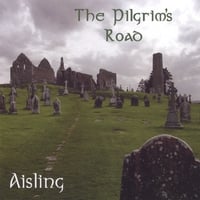 Today was the big day - our climb of Kala Patthar. We headed up the mountain after breakfast in the tea house. That was an adventure all in itself because a pony came in the back door and walked down the hallway. The Sherpas chased it back outside before its pal could come in and do the same. That would have been even more exciting - two ponies in the tea house.
Today was the big day - our climb of Kala Patthar. We headed up the mountain after breakfast in the tea house. That was an adventure all in itself because a pony came in the back door and walked down the hallway. The Sherpas chased it back outside before its pal could come in and do the same. That would have been even more exciting - two ponies in the tea house.Gorak Shep sits atop the lateral moraine on the western side of the Khumbu glacier. On the western edge of the moraine is a dry lake bed, so you have to climb down the moraine to the lake bed and then start climbing Kala Patthar. You can probably see the circle there that's demarcated by a stone ring. That's the cricket pitch for Gorak Shep. It's beyond my ken how anyone would have the breath to run around at this elevation to play cricket or football, but, then, I'm a lowlander living at 900 ft elevation. Gorak Shep is at 16,990 ft.
 The first pitch up the mountain is a bit steep and so you gain elevation rather quickly. I took a series of photos of our campsite at Gorak Shep. This village used to be Everest Base Camp, but now is a seasonal village that caters to climbers and trekkers.
The first pitch up the mountain is a bit steep and so you gain elevation rather quickly. I took a series of photos of our campsite at Gorak Shep. This village used to be Everest Base Camp, but now is a seasonal village that caters to climbers and trekkers.Our line of green tents is out behind our teahouse (off to the right, just out of the frame of this image). There's a blue toilet tent just up the hill from our tents. We usually had an outhouse or an inside squat toilet at the tea houses, but the staff always dug a trench for a toilet tent as well. At some of our camps, this was the most luxurious and clean spot to do your business. The hole was covered up with the dirt removed for the trench as we broke camp, but I wondered if there was more to the clean-up since the outhouses compost human waste for the fields where crops are grown. One can imagine that there would be an incredible amount of sewage to deal with each climbing and trekking season.
 We tried to keep together for the first pitch of the climb, but it didn't take long for our group to split up. Monika and Steve ended up going fastest, followed by Thilo, Chris and myself, and then John, Megan and Kyle. These three ended up turning around and returning to camp - altitude was truly a wildcard on this day. Kyle came back later in the day and pushed through to the summit, but paid the price later on. He came back to the tea house totally chilled and sick and slept through tea, dinner and on to the morning. He pretty much laid down on a bench in the tea house and didn't rouse again until the next day. Jon Miller filmed an interview with him, which, if I recall, was pretty incoherent.
We tried to keep together for the first pitch of the climb, but it didn't take long for our group to split up. Monika and Steve ended up going fastest, followed by Thilo, Chris and myself, and then John, Megan and Kyle. These three ended up turning around and returning to camp - altitude was truly a wildcard on this day. Kyle came back later in the day and pushed through to the summit, but paid the price later on. He came back to the tea house totally chilled and sick and slept through tea, dinner and on to the morning. He pretty much laid down on a bench in the tea house and didn't rouse again until the next day. Jon Miller filmed an interview with him, which, if I recall, was pretty incoherent.
Yep, we're getting up there and our camp is disappearing. The view of the Khumbu glacier and the peaks flanking it was stunning. You can see how small Gorak Shep is - just a few buildings.

I think this is the view to the south. I'm not sure what peaks those are.

This is Changtse - the closest peak to Everest on the Tibet side of the border.

Pumo Ri dominated our view as we climbed Kala Patthar. During one of our rest stops we spotted some climbers on their way to the summit, and we found their advance base camp. I wish I had brought my binocular with me to have gotten a better look, but I was trying to keep my pack very light for this climb - only spare layers and water, plus my camera gear.

Gorak Shep has all but disappeared from view at this point, but the Khumbu glacier is there in all its glory. We couldn't have asked for a better morning to climb and to see the mountains.

Aha! Our first glimpse of Everest, up close and personal, just coming above the ridge of Nuptse there in the center.

This landscape inspires one to sit and ponder. Well, actually, the elevation motivates one to sit and rest, but that presents a good opportunity for reflection. I loved it!

Nuptse

There were a lot of huge glaciers coming off the flanks of Nuptse, down to the Khumbu glacier.

Now, this is an ice fall. Those seracs are probably more than 100 ft tall, but it's hard to get a sense of scale without a reference point.

The guy in orange was described as a "crazy man" by Tendi, our lead trail Sherpa. He acted as if he were drunk or high on something.

Another view of the glacier coming off Nuptse. You really have a sense of how glaciers are rivers of ice when you can see one merging into another.
 The rocks and boulders capping the Khumbu glacier serve as a reminder of the force of nature to wear away the slopes of these mountains. These Himalayas are the biggest mountains in the world - the result of crashing continents, but they are being brought down before our eyes. To put this in perspective, one has to travel back in geological time about 400 million years, to another era when the Appalachians of North America and the Sperrin Mountains of Northern Ireland were the size of the Himalayas. Anyone familiar with these two mountain ranges (they were connected at the time of their orogeny) will have a hard time imagining that they were mighty giants in their day. Over the course of millions of years, erosion wore them down to the nubs that remain in our day and time.
The rocks and boulders capping the Khumbu glacier serve as a reminder of the force of nature to wear away the slopes of these mountains. These Himalayas are the biggest mountains in the world - the result of crashing continents, but they are being brought down before our eyes. To put this in perspective, one has to travel back in geological time about 400 million years, to another era when the Appalachians of North America and the Sperrin Mountains of Northern Ireland were the size of the Himalayas. Anyone familiar with these two mountain ranges (they were connected at the time of their orogeny) will have a hard time imagining that they were mighty giants in their day. Over the course of millions of years, erosion wore them down to the nubs that remain in our day and time.
And there, my friends, is the mother of all mountains - Sagamartha, Chomulungma, Everest - whatever you call it, it's the biggest mountain in the world. From the summit of Kala Patthar, it's still two freakin' miles above your head. I've always wanted to see this with my own eyes, and now this sight is one of my fondest memories.

We had been hearing the roar of avalanches all morning as we climbed, but by the time we heard them, they would already be done. I caught this one early enough that I was able to snap a photo as it was near the bottom of the slide.
 The upper third of Kala Patthar is rock, snow and ice - at least it was for us. I'm sure it's just rock later in the season - black rock, the namesake of the mountain. Kala Patthar means "black stone."
The upper third of Kala Patthar is rock, snow and ice - at least it was for us. I'm sure it's just rock later in the season - black rock, the namesake of the mountain. Kala Patthar means "black stone."Trekking poles came in pretty handy here. At 18,000 feet you take a few steps, breathe hard, say a few choice words, and then go on. This was my biggest challenge, but I decided that I would make it to the top if I just took small steps and took my time. It worked.

The reward is a spectacular view of Pumo Ri, which I forgot to photograph from here, plus Everest and the other big mountains, and Everest Base Camp. It's a sprawling tent city on the western edge of the Khumbu glacier.

Our two Sherpas who assisted us: Pasang Dawa Sherpa and Tendi Sherpa (in the pink hat). Pasang climbed the mountain in just a couple of hours, bringing two hot thermoses of orange drink and wearing pink Crocs sans socks.

Thilo brought a flag from his home town in Germany.

A spectacular view of Everest Base Camp and the Khumbu Ice Fall, which is what the climbers have to negotiate on their climb to advance base camp.

Everest and prayer flags.

The clouds are rolling in, but Everest is still visible above them.

Steve thought it would be neat to play his flute at 18,230 feet - it wasn't all that successful. One has to be able to breathe to play the flute.

I loved Tendi's pink hat - it reminded me of a Smurf's hat, but pink instead of blue.

Steve brought some prayer flags to the summit.

Last view of Everest before the clouds filled in and we headed down to Gorak Shep.

Interesting rocks here - looks like fossils, but aren't.
Here is my blog entry from Gorak Shep: climbing Kala Patthar.











1 comment:
I was recently in Kala Patthar And I was intrigued with the rocks with fish or tadpoles fossils. It seems limestone. Why do you say they aren't fossils? Paula
Post a Comment